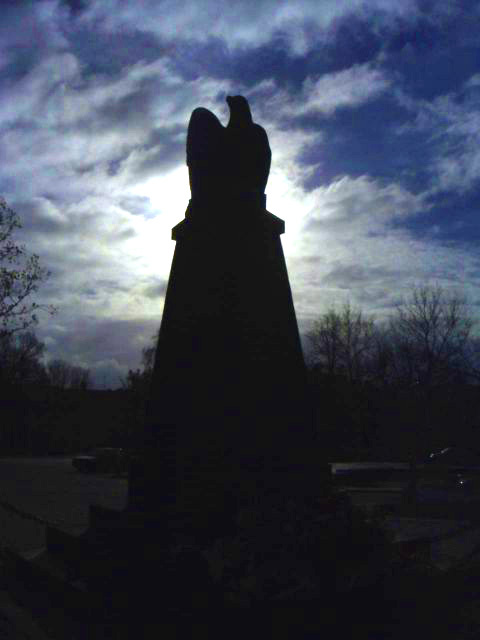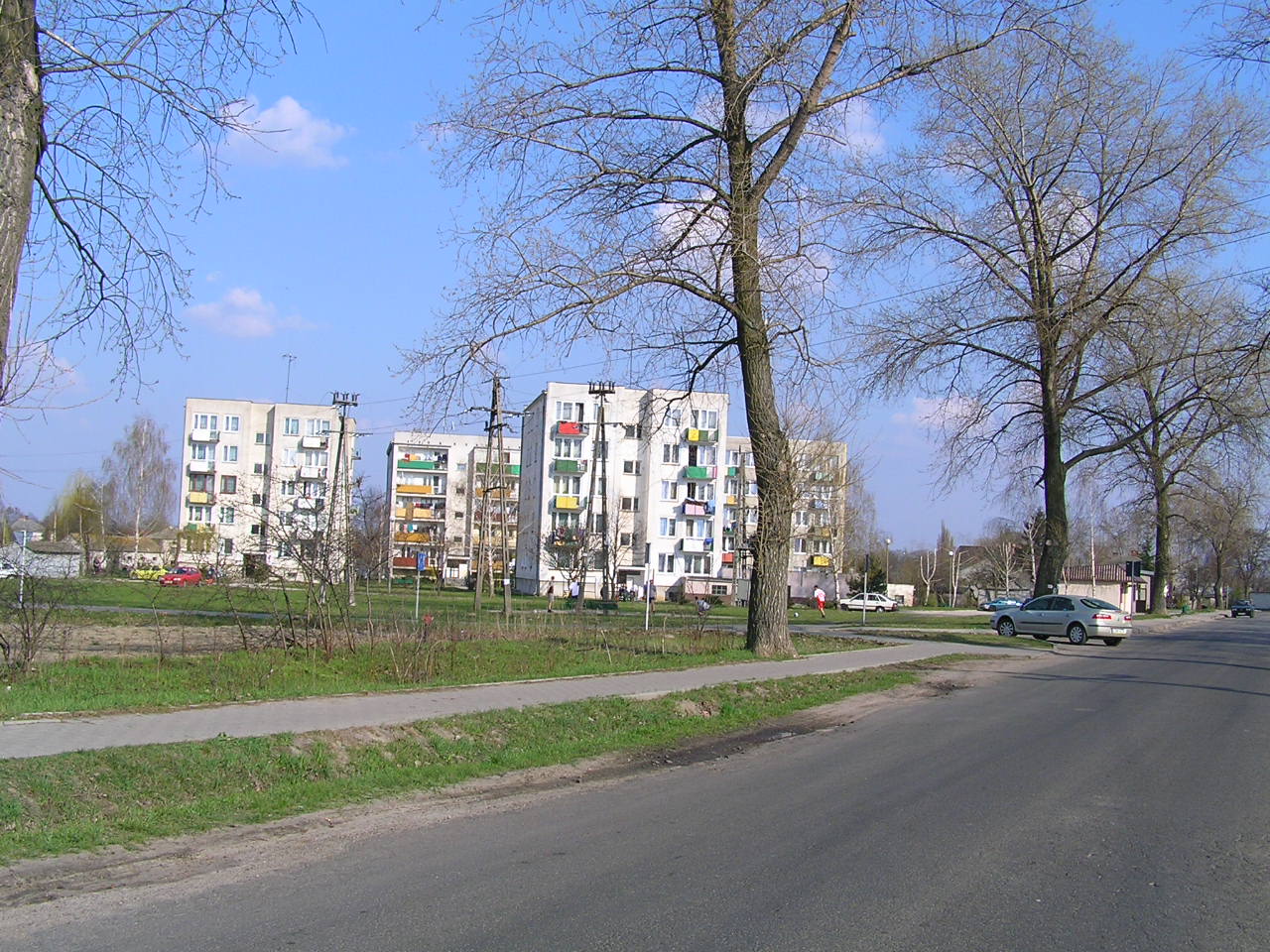|
Międzyrzec Podlaski Ghetto
The Międzyrzec Podlaski Ghetto was one of the Nazi ghettos established for the confinement and persecution of the Jewish population of Międzyrzec Podlaski in the General Government territory of occupied Poland. The ghetto was liquidated in stages between 1942 and 1943 as part of the "Final Solution", with all Jews either killed on the spot in mass shooting actions or deported to Treblinka and Majdanek death camps. Ghetto history At the end of September 1939, during the Soviet invasion of Poland, the Red Army occupied the city of Międzyrzec Podlaski. At the beginning of October, the Soviet Union handed over the city to Germany as part of the German-Soviet Frontier Treaty amended to the secret Hitler-Stalin Pact against Poland in 1939. Following the exchange, approximately 2,000 of the city’s Jews left for the territories of Poland annexed by the Soviet Union. The Germans set up a transfer ghetto in the historic neighbourhood of Szmulowizna. It held 20,000 Jewish prisoners at ... [...More Info...] [...Related Items...] OR: [Wikipedia] [Google] [Baidu] |
Międzyrzec Podlaski
Międzyrzec Podlaski ( la, Meserici, german: Meseritz) is a city in Biała Podlaska County, Lublin Voivodeship, Poland, with the population of 17,162 inhabitants . The total area of the city is . Międzyrzec is located near the Krzna river, not far from the border with Belarus. History The first official mention of Międzyrzec Podlaski as a town dates back to 1434, or (alternatively) 1455 and 1477 according to different historical sources. At that time, the newly established town was located along a busy merchant route from Lukow to Brzesc nad Bugiem. Międzyrzec quickly developed: in 1486, a Roman Catholic church was built here, and town's owner, Jan Nassutowicz, received permission for fairs. In 1598, a salt warehouse was opened, the town also was center of beer industry. The period of peace and prosperity ended in 1648, when Miedzyrzec was raided by Zaporozhian Cossacks. During the Deluge (history), Swedish invasion of Poland, the town was ransacked and burned by Swedes, who r ... [...More Info...] [...Related Items...] OR: [Wikipedia] [Google] [Baidu] |
Ghettos In Lublin District
A ghetto, often called ''the'' ghetto, is a part of a city in which members of a minority group live, especially as a result of political, social, legal, environmental or economic pressure. Ghettos are often known for being more Poverty, impoverished than other areas of the city. Versions of the ghetto appear across the world, each with their own names, classifications, and groupings of people. The term was originally used for the Venetian Ghetto in Venice, Italy, as early as 1516, to describe the part of the city where Jewish people were restricted to live and thus Religious segregation, segregated from other people. However, early societies may have formed their own versions of the same structure; words resembling ''ghetto'' in meaning appear in Hebrew language, Hebrew, Yiddish, Italian language, Italian, Germanic languages, Germanic, Old French, and Latin. During the Holocaust, more than 1,000 Nazi ghettos were established to hold Jewish populations, with the goal of exploit ... [...More Info...] [...Related Items...] OR: [Wikipedia] [Google] [Baidu] |
Timeline Of Treblinka
This article presents the timeline of events at Treblinka extermination camp during the most deadly phase of the Holocaust in World War II.Clancy Young"Treblinka Death Camp Day-by-Day" H.E.A.R.T - Holocaust Education & Archive Research Team. Tables with record of daily deportations.Retrieved 5 November 2015 via Internet Archive Donat, Alexander, ''The Death Camp Treblinka''. Holocaust Library, New York, 1979. All deportations were from German occupied Poland, except where noted. In most cases the number of deportees are not exact figures, but rather approximations. Days are listed in chronological order, nevertheless, a number of dates are missing from the below tables which means only that no way bills survived for those particular dates. It does not mean that transports were not arriving or have not been processed from layover yards, when applicable. Day-by-day See also *Jewish ghettos in German-occupied Poland References {{DEFAULTSORT:Timeline of Treblinka Wars ... [...More Info...] [...Related Items...] OR: [Wikipedia] [Google] [Baidu] |
Polish Righteous
The citizens of Poland have the world's highest count of individuals who have been recognized by Yad Vashem of Jerusalem as the Polish Righteous Among the Nations, for saving Jews from extermination during the Holocaust in World War II. There are Polish men and women recognized as Righteous Among the Nations, over a quarter of the recognized by Yad Vashem in total. The list of Righteous is not comprehensive and it is estimated that hundreds of thousands of Poles concealed and aided hundreds of thousands of their Polish-Jewish neighbors. Many of these initiatives were carried out by individuals, but there also existed organized networks of Polish resistance which were dedicated to aiding Jews – most notably, the ''Żegota'' organization. In German-occupied Poland, the task of rescuing Jews was difficult and dangerous. All household members were subject to capital punishment if a Jew was found concealed in their home or on their property. Activities Before World W ... [...More Info...] [...Related Items...] OR: [Wikipedia] [Google] [Baidu] |
Judenfrei
''Judenfrei'' (, "free of Jews") and ''judenrein'' (, "clean of Jews") are terms of Nazi origin to designate an area that has been "cleansed" of Jews during The Holocaust. While ''judenfrei'' refers merely to "freeing" an area of all of its Jewish inhabitants, the term ''judenrein'' (literally "clean of Jews") has the even stronger connotation that any trace of Jewish blood had been removed as an alleged impurity in the minds of the criminal perpetrators. These terms of racial discrimination and racial abuse are intrinsic to Nazi anti-Semitism and were used by the Nazis in Germany before World War II and in occupied countries such as Poland in 1939. ''Judenfrei'' describes the local Jewish population having been removed from a town, region, or country by forced evacuation during the Holocaust, though many Jews were hidden by local people. Removal methods included forced re-housing in Nazi ghettos especially in eastern Europe, and forced removal or Resettlement to the East by ... [...More Info...] [...Related Items...] OR: [Wikipedia] [Google] [Baidu] |
Ordnungspolizei
The ''Ordnungspolizei'' (), abbreviated ''Orpo'', meaning "Order Police", were the uniformed police force in Nazi Germany from 1936 to 1945. The Orpo organisation was absorbed into the Nazi monopoly on power after regional police jurisdiction was removed in favour of the central Nazi government ("Reich-ification", ''Verreichlichung'', of the police). The Orpo was controlled nominally by the Interior Ministry, but its executive functions rested with the leadership of the '' SS'' until the end of World War II. Owing to their green uniforms, Orpo were also referred to as ''Grüne Polizei'' (green police). The force was first established as a centralised organisation uniting the municipal, city, and rural uniformed police that had been organised on a state-by-state basis. The ''Ordnungspolizei'' encompassed virtually all of Nazi Germany's law-enforcement and emergency response organisations, including fire brigades, coast guard, and civil defence. In the prewar period, Heinrich Himm ... [...More Info...] [...Related Items...] OR: [Wikipedia] [Google] [Baidu] |
Reserve Police Battalion 101
Reserve Police Battalion 101 (german: Reserve-Polizei-Bataillon 101) was in Nazi Germany a paramilitary formation of the uniformed police force known as Order Police (''Ordnungspolizei#Police battalions, Ordnungspolizei'', abbreviated as Orpo), operating under the leadership of the Schutzstaffel, SS. Formed in Hamburg, it was deployed in September 1939 along with the Wehrmacht army in the invasion of Poland. Initially, the Police Battalion 101 guarded Polish prisoners of war behind German lines, and carried out Expulsion of Poles by Nazi Germany, expulsion of Poles, called "resettlement actions", in the new ''Warthegau'' territory around Poznań and Łódź. Following the personnel change and retraining from May 1941 until June 1942, it became a major perpetrator of the Holocaust in occupied Poland. The battalion got attention from the wider public due to the work of historians Christopher Browning, Christopher R. Browning and Daniel Goldhagen. History Between 1939 and 1945, ... [...More Info...] [...Related Items...] OR: [Wikipedia] [Google] [Baidu] |
Trawniki Men
Trawniki is a village in Świdnik County, Lublin Voivodeship, in eastern Poland. It is the seat of the present-day gmina (administrative district) called Gmina Trawniki. It lies approximately south-east of Świdnik and south-east of the regional capital Lublin. The village has a population of 2,893. History During World War II and the Nazi occupation of Poland, Trawniki was the location of the Trawniki concentration camp. This camp provided slave labourers for nearby industrial plants of the SS ''Ostindustrie''. They worked in appalling conditions with little food, and many died of disease, malnutrition and ill treatment. From September 1941 until July 1944, the camp was also used for training guards recruited from Soviet Union, Soviet Prisoner of war, POWs, who were known as "Hiwi (volunteer), Hiwi" (German letterword for 'Hilfswillige', lit. European non-Germans in the German armed forces during World War II, "those willing to help"), for service with Nazi Germany, Auxilia ... [...More Info...] [...Related Items...] OR: [Wikipedia] [Google] [Baidu] |
Oberleutnant
() is the highest lieutenant officer rank in the German-speaking armed forces of Germany (Bundeswehr), the Austrian Armed Forces, and the Swiss Armed Forces. Austria Germany In the German Army, it dates from the early 19th century. Translated as "senior lieutenant", the rank is typically bestowed upon commissioned officers after five to six years of active-duty service. is used by both the German Army and the German Air Force. In the NATO military comparison system, a German is the equivalent of a First lieutenant in the Army/Air Forces of Allied nations. ;Other uses The equivalent naval rank is ''Oberleutnant zur See''. In Nazi Germany, within the SS, SA and Waffen-SS, the rank of Obersturmführer was considered the equivalent of an in the German Army. National People's Army In the GDR National People's Army (NPA) the rank was the highest lieutenant rank, until 1990. This was in reference to Soviet military doctrine and in line with other armed forces of ... [...More Info...] [...Related Items...] OR: [Wikipedia] [Google] [Baidu] |
Treblinka Extermination Camp
Treblinka () was an extermination camp, built and operated by Nazi Germany in occupied Poland during World War II. It was in a forest north-east of Warsaw, south of the village of Treblinka in what is now the Masovian Voivodeship. The camp operated between 23 July 1942 and 19 October 1943 as part of Operation Reinhard, the deadliest phase of the Final Solution. During this time, it is estimated that between 700,000 and 900,000 Jews were murdered in its gas chambers, along with 2,000 Romani people. More Jews were murdered at Treblinka than at any other Nazi extermination camp apart from Auschwitz-Birkenau. Managed by the German SS with assistance from Trawniki guards – recruited from among Soviet POWs to serve with the Germans – the camp consisted of two separate units. Treblinka I was a forced-labour camp (''Arbeitslager'') whose prisoners worked in the gravel pit or irrigation area and in the forest, where they cut wood to fuel the cremation pits. Between 1941 and 1 ... [...More Info...] [...Related Items...] OR: [Wikipedia] [Google] [Baidu] |
Jewish Ghettos In German-occupied Poland
Ghettos were established by Nazi Germany in hundreds of locations across occupied Poland after the German invasion of Poland.Yitzhak Arad, ''Belzec, Sobibor, Treblinka.'' Indiana University Press, Bloomington and Indianapolis, 1987.''Biuletyn Głównej Komisji Badania Zbrodni Hitlerowskich w Polsce,'' Wydawnictwo Prawnicze, 1960. Most ghettos were established between October 1939 and July 1942 in order to confine and segregate Poland's Jewish population of about 3.5 million for the purpose of persecution, terror, and exploitation. In smaller towns, ghettos often served as staging points for Jewish and mass deportation actions, while in the urban centers they resembled walled-off prison-islands described by some historians as little more than instruments of "slow, passive murder", with dead bodies littering the streets. In most cases, the larger ghettos did not correspond to traditional Jewish neighborhoods, and non-Jewish Poles and members of other ethnic groups were or ... [...More Info...] [...Related Items...] OR: [Wikipedia] [Google] [Baidu] |

_Panorama.jpg)

.jpg)


